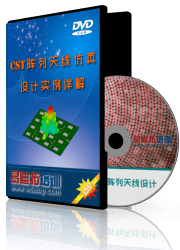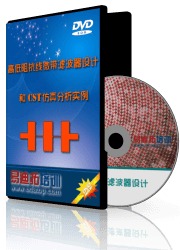- 易迪拓培训,专注于微波、射频、天线设计工程师的培养
Microstrip Coupler - CST2013 MWS Examples

General Description
In this example the S-parameter calculation of a directional strip line coupler is presented. The simulation is performed using waveguide ports.
Adaptive energy based meshing is applied to ensure that the obtained results are accurate regarding a certain accuracy level.
Structure Generation
The background material is defined as vacuum, the units are changed to millimeters, gigahertz and nanoseconds, and the boundary conditions are set to "electric". Furthermore, the mesh settings are changed to account for the planar microstrip structure.
During the construction of the model, the working coordinate system is used to define objects relative to each other. The structure is modelled by defining bricks as the strip line and the substrate. The bends are created as a solid of rotation defined by the microstrip's front face, an axis placed at the center of the circular path described by the bend, and the angle, which equals ninety degrees.
After adding both parts of the microstrip line, its new front face is extruded up to the center of the substrate. With the working coordinate system placed at the center of the substrate's top face, the first quarter of the microstrip lines is mirrored, copied and combined twice.
Solver Setup
The frequency range's upper and lower limit are set to 0.8 GHz and 1 GHz, respectively.
Three monitors are defined in order to examine the electric field, the magnetic field, and the power flow at 0.9 GHz. Four waveguide ports are created at each end of the strip line to perform the S-parameter calculation.
The excitation signal is a sine modulated Gaussian shaped pulse. Because of the symmetry of the structure all reflection coefficients will be identical as well as several transmission coefficients. These S-Parameter symmetries are utilized such that only one simulation has to be performed in order to get the entire S-Matrix.
Post Processing
The calculated port modes of the waveguide ports can be examined in the folder 2D/3D Results, while the results of the mesh adaption are added to the folder 1D Results  Adaptive Meshing. The deviation of the scattering parameters in the last mesh adaption pass complies with the desired accuracy.
Adaptive Meshing. The deviation of the scattering parameters in the last mesh adaption pass complies with the desired accuracy.
The S-parameter are accessible via the folder 1D Results. The monitors at 0.9 GHz illustrate the directional coupling of the device.
CST微波工作室培训课程套装,专家讲解,视频教学,帮助您快速学习掌握CST设计应用
上一篇: RCS Calculation of a Large Transport Ship - CST2013 MWS Examples
下一篇: PEC Cube - CST2013 MWS Examples
CST中文视频培训教程 | More...
 最全面、最专业的CST微波工作室视频培训课程,可以帮助您从零开始,全面系统学习CST的设计应用【More..】
最全面、最专业的CST微波工作室视频培训课程,可以帮助您从零开始,全面系统学习CST的设计应用【More..】
频道总排行
- Rectangular Waveguide Tutorial
- FSS: Simulation of Resonator
- CST2013 MWS Examples: Thermal C
- Dipole Antenna Array - CST201
- CST MWS Examples - CST2013 M
- Microstrip Radial Stub - CST2
- Dielectric Resonator Antenna -
- Interdigital Capacitor - CST20
- CST2013 MWS Examples: Biological
- Lossy Loaded Waveguide - CST2











 沪公网安备 31011202014168号
沪公网安备 31011202014168号
 1427313829
1427313829 旺旺在线
旺旺在线 Skype Online
Skype Online 13761612886
13761612886 官方淘宝店
官方淘宝店
